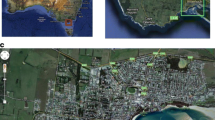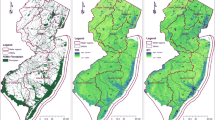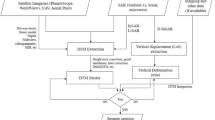Abstract
As an important topographic attribute widely-used in precision agriculture, topographic wetness index (TWI) is designed to quantify the effect of local topography on hydrological processes and for modeling the spatial distribution of soil moisture and surface saturation. This index is formulated as TWI = ln(a/tanβ), where a is the upslope contributing area per unit contour length (or Specific Catchment Area, SCA) and tanβ is the local slope gradient for estimating a hydraulic gradient. The computation of both a and tanβ need to reflect impacts of local terrain on local drainage. Many of the existing flow direction algorithms for computing a use global parameters, which lead to unrealistic partitioning of flow. β is often approximated by slope gradient around the pixel. In fact, the downslope gradient of the pixel is a better approximation of β. This paper examines how TWI is impacted by a multiple flow routing algorithm adaptive to local terrain and the employment of maximum downslope gradient as β. The adaptive multiple flow routing algorithm partitions flow by altering the flow partition parameter based on local maximum downslope gradient. The proposed approach for computing TWI is quantitatively evaluated using four types of artificial terrains constructed as DEMs with a series of resolutions (1, 5, 10, 20, and 30 m), respectively. The result shows that the error of TWI computed using the proposed approach is generally lower than that of TWI by the widely used approach. The new approach was applied to a low-relief agricultural catchment (about 60 km2) in the Nenjiang watershed, Northeastern China. The results of this application show that the distribution of TWI by the proposed approach reflects local terrain conditions better.





Similar content being viewed by others
References
Barling, R. D., Moore, I. D., & Grayson, R. B. (1994). A quasi-dynamic wetness index for characterizing the spatial distribution of zones of surface saturation and soil water content. Water Resources Research, 30, 1029–1044.
Beven, K., & Kirkby, N. (1979). A physically based variable contributing area model of basin hydrology. Hydrological Sciences Bulletin, 24, 43–69.
Burrough, P. A., & McDonnell, R. A. (1998). Principles of geographic information systems (p. 333). New York: Oxford University Press.
Burrough, P., van Gaans, P., & MacMillan, R. (2000). High-resolution landform classification using fuzzy k-means. Fuzzy Sets and Systems, 113, 37–52.
Freeman, T. G. (1991). Calculating catchment area with divergent flow based on a regular grid. Computers & Geosciences, 17, 413–422.
Gallant, J. C., & Wilson, J. P. (2000). Primary topographic attributes. In J. P. Wilson & J. C. Gallant (Eds.), Terrain analysis: Principles and applications (pp. 51–85). New York: John Wiley & Sons, Inc.
Güntner, A., Seibert, J., & Uhlenbrook, S. (2004). Modeling spatial patterns of saturated areas: An evaluation of different terrain indices. Water Resources Research, 40, W05114. doi:10.1029/2003WR002864.
Hjerdt, K., McDonnell, J., Seibert, J., & Rodhe, A. (2004). A new topographic index to quantify downslope controls on local drainage. Water Resources Research, 40, W05602. doi:10.1029/2004WR003130.
Kyveryga, P. M., Blackmer, T. M., & Caragea, P. C. (2008). Using soil and terrain attributes to delineate management zones in corn yield response to nitrogen fertilization. In R. Khosla (Ed.), Precision agriculture: Proceedings of the 9th international conference on precision agriculture (CD-ROM). Denver, Colorado, USA.
Lindsay, J. B. (2003). A physically based model for calculating contributing area on hillslopes and along valley bottoms. Water Resources Research, 39, 1332. doi:10.1029/2003WR002576.
Marques da Silva, J. R., & Alexandre, C. (2005). Spatial variability of irrigated corn yield in relation to field topography and soil chemical characteristics. Precision Agriculture, 6, 453–466.
Moore, I., Gessler, P., Nielsen, G., & Peterson, G. (1993). Soil attribute prediction using terrain analysis. Soil Science Society of America Journal, 57, 443–452.
O’Callaghan, J. F., & Mark, D. M. (1984). The extraction of drainage networks from digital elevation data. Computer Vision, Graphics, and Image Processing, 28, 323–344.
O’Loughlin, E. M. (1986). Prediction of surface saturation zones in natural catchments by topographic analysis. Water Resources Research, 22, 794–804.
Pan, F., Peters-Lidard, C., Sale, M., & King, A. (2004). A comparison of geographical information system-based algorithms for computing the TOPMODEL topographic index. Water Resources Research, 40, W06303. doi:10.1029/2004WR003069.
Planchon, O., & Darboux, F. (2001). A fast, simple and versatile algorithm to fill the depressions of digital elevation models. Catena, 42, 159–176.
Qin, C.-Z., Zhu, A.-X., Li, B.-L., Pei, T., & Zhou, C.-H. (2006). Review of multiple flow direction algorithms based on gridded digital elevation models. Earth Science Frontiers, 13, 91–98. (in Chinese with English abstract).
Qin, C.-Z., Zhu, A.-X., Pei, T., Li, B.-L., Zhou, C.-H., & Yang, L. (2007). An adaptive approach to selecting a flow-partition exponent for a multiple-flow-direction algorithm. International Journal of Geographical Information Science, 21, 443–458.
Quinn, P., Beven, K., Chevalier, P., & Planchon, O. (1991). The prediction of hillslope flow paths for distributed hydrological modeling using digital terrain models. Hydrological Processes, 5, 59–79.
Quinn, P., Beven, K. J., & Lamb, R. (1995). The ln(α/tanβ) index: How to calculate it and how to use it within the TOPMODEL framework. Hydrological Processes, 9, 161–182.
Schmidt, F., & Persson, A. (2003). Comparison of DEM data capture and topographic wetness indices. Precision Agriculture, 4, 179–192.
Vitharana, U., van Meirvenne, M., Simpson, D., Cockx, L., & de Baerdemaeker, J. (2008). Key soil and topographic properties to delineate potential management classes for precision agriculture in the European loess area. Geoderma, 143, 206–215.
Wolock, D. M., & McCabe, G. J. (1995). Comparison of single and multiple flow direction algorithms for computing topographic parameters. Water Resources Research, 31, 1315–1324.
Zhou, Q., & Liu, X. (2002). Error assessment of grid-based flow routing algorithms used in hydrological models. International Journal of Geographical Information Science, 16, 819–842.
Zhu, A.-X., Yang, L., Li, B.-L., Qin, C.-Z., Pei, T., & Liu, B.-Y. (2009). Construction of membership functions for predictive soil mapping under fuzzy logic. Geoderma. doi:10.1016/j.geoderma.2009.05.024.
Acknowledgements
This study was supported by the National Natural Science Foundation of China (40501056; 40971235), the National Basic Research Program of China (2007CB407207), the National Key Technology R&D Program of China (2007BAC15B01), and the Knowledge Innovation Programs of the Chinese Academy of Sciences (KZCX2-YW-Q10-1-5). Supports from the Institute of Geographical Sciences and Natural Resources Research, the State Key Laboratory of Resources and Environmental Information Systems, and the University of Wisconsin-Madison (through its Vilas Associate Program and the Hamel Faculty Fellow Program) are also appreciated. We thank the anonymous reviewers and the editor for their constructive comments on an earlier version of this paper. We thank Dr. Yuxin Miao for kindly sharing the literatures in the 9th International Conference on Precision Agriculture.
Author information
Authors and Affiliations
Corresponding author
Rights and permissions
About this article
Cite this article
Qin, CZ., Zhu, AX., Pei, T. et al. An approach to computing topographic wetness index based on maximum downslope gradient. Precision Agric 12, 32–43 (2011). https://doi.org/10.1007/s11119-009-9152-y
Published:
Issue Date:
DOI: https://doi.org/10.1007/s11119-009-9152-y




